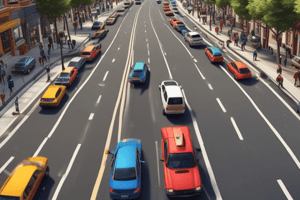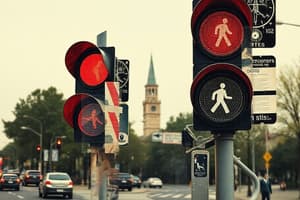Podcast
Questions and Answers
?
?
- (correct)
** ** ?
** ** ?
- (correct)
** ** ?
** ** ?
- (correct)
Which one of these is the most correct?
Which one of these is the most correct?
?
?
?
?
?
?
Flashcards are hidden until you start studying
Study Notes
Road Safety Measures for Crossing the Street
Introduction
With the ever-growing number of vehicles on our roads, road safety becomes increasingly crucial, especially for pedestrians. According to the World Health Organization, around 1.35 million people die annually from road traffic accidents, with approximately 270,000 being pedestrian fatalities. To mitigate these risks, various strategies can be employed, focusing primarily on designing and implementing effective road safety measures.
Designated Walking Lanes and Pedestrian Crossings
A fundamental aspect of ensuring pedestrian safety is to provide designated walking lanes and pedestrian crossings distinct from vehicle lanes. Separate pedestrian infrastructure helps minimize the risk of accidents and allows for safer traffic flow for all road users.
Pedestrian-Friendly Signals
Implementing pedestrian-friendly signals like countdown timers can significantly reduce the risk of accidents. These signals enable pedestrians to better anticipate the onset of traffic and cross safely when appropriate.
Driver Education and Public Awareness Campaigns
Educating drivers about the importance of pedestrian safety is essential. Reminding them to be vigilant, particularly in areas with heavy foot traffic or where young people are present, can lead to safer road environments for all users.
Community Engagement
Community involvement plays a vital role in promoting and maintaining pedestrian safety. Encouraging community-led initiatives such as volunteer groups that monitor pedestrian crossings and report any safety concerns helps ensure that everyone takes responsibility for ensuring a safe environment.
Crosswalk Design
Crosswalk design is crucial in improving pedestrian safety. High-tech tools like lighting, video cameras, signs, and flags can enhance safety by providing better visibility and alerting both drivers and pedestrians to potential hazards. Additionally, existing law enforcement cameras at intersections may further improve pedestrian safety by reducing aggressive driving behaviors near crosswalks.
Low-Cost Options for Transportation Agencies
Transportation agencies can also consider lower-cost options to make crosswalks safer. For example, brightly colored crossing flags carried by pedestrians across the roadway have been shown to reduce the likelihood of vehicles going through a crosswalk while a pedestrian is already there. Gateways, reflective signs placed several feet tall and meant to alert drivers approaching a crosswalk, have also proven effective in increasing driver yielding behavior.
Conclusion
Ensuring road safety for pedestrians requires a multifaceted approach involving government efforts, community engagement, and individual awareness. By implementing these measures, we can work together to create safer streets and reduce the risk of pedestrian accidents. Remember, everyone can contribute to pedestrian safety—from using designated walking lanes and pedestrian crossings to educating others about safe practices. Let's strive to keep our roads safe for all.
Studying That Suits You
Use AI to generate personalized quizzes and flashcards to suit your learning preferences.




